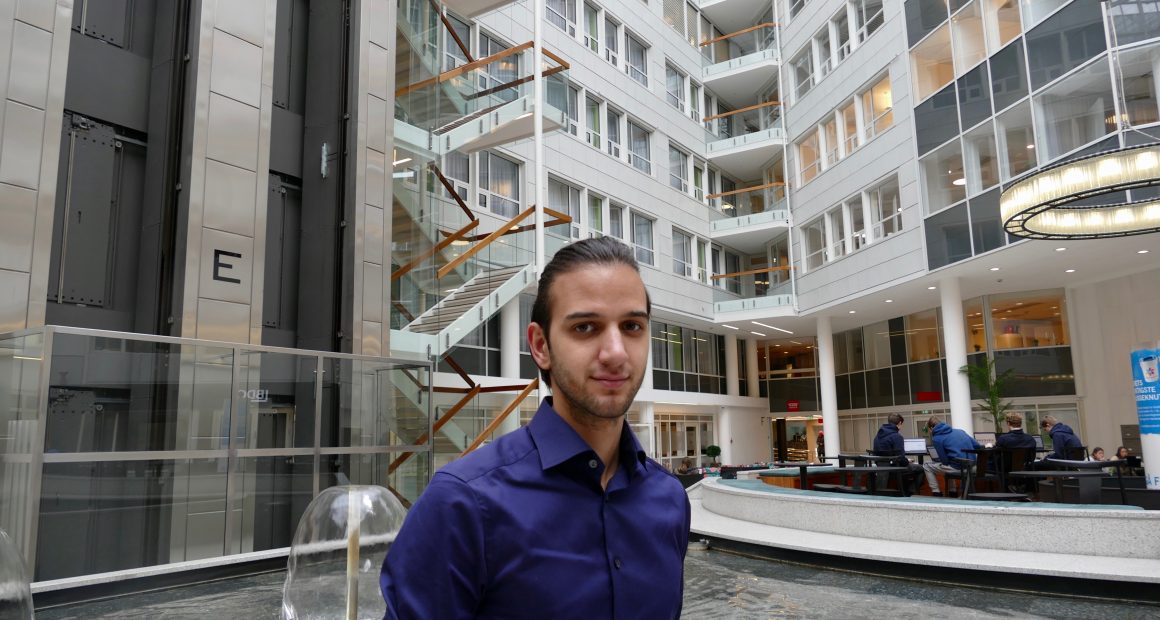Eric Wall works for Arcane Crypto, owner of Kryptografen and Arcane Assets.
What is the easiest way to scare a fifty-five-year-old businessman? Say the word ‘cryptocurrency’ and they will most likely jump off their chair into the abyss—never to be seen or heard from again. It’s understandable, they should be scared. It’s the future and when cryptocurrency expert Eric Wall talks, people listen. The 28-year-old, born in Linköping in Sweden, enjoys twitter, VR, and cryptocurrency. He is a clean cut, eloquent speaker, and brings new dimensions to the term computer geek.
Computer science major turned day trader
Starting at the University of Lund in 2011, he was at The Faculty of Engineering, studying communication networks and anonymity technologies. One of the systems he analyzed was the Tor network, a network and online browser where users can explore the internet without tracking or surveillance. Here, he discovered cryptocurrency. In 2012 he sent his first purchase order to Mt. Gox, the bitcoin exchange based in Shibuya, Tokyo.
“At first, I just wanted to look up the price of Bitcoin, then I discovered that it had changed, it had gone up to 100% in a year. That is what got me thinking: this is an asset that is completely new, one that i might be able to fundamentally understand, but what it is that makes this asset move? It was trading but why?” This was at the time when Bitcoin was valued at $8.
He had a computer science background, and this was in a sense purely a computer science asset that had no history. He was interested in economics and trading, so this was a match made in heaven. He became a bitcoin day trader. As the years of his master’s degree went on, he became heavily involved in other cryptocurrencies as well. His degree started to gravitate towards blockchain specialization. One of his peers at the PhD level, Christopher Jämthagen, became his mentor.
“He was also interested in cryptocurrency and blockchain and went on to be one of the early Lightning developers. He, on his own accord, had a course on blockchain technology. I wrote my master’s thesis under him.”
Wall became the first in Sweden to write his master’s thesis on blockchain when he started in 2015. This is where things get interesting. The master’s titled: ‘How to Create a Distributed Securities Depository Using Blockchain Technology and Smart Contracts,’ landed him a job at Cinnober, a world leading provider of clearing and exchange technology, with clients such as The London Metal Exchange (LME), the Australian Securities Exchange (ASX) and many others. Cinnober was seen by many as the number one competitor to Nasdaq as an exchange and clearinghouse technology provider.
“There are three layers in the trading world, there is trading, clearing and settlement. For securities, there is a final registry that keeps track of who owns which stock after a trade. This is typically done in a database called a central securities depository.” Cinnober was interested to see whether or not they could use blockchain technology to build a distributed security depository. Wall became the leader of this project.
As time went on, he became the general cryptocurrency expert at the company and eventually the formal head of blockchain and cryptocurrency. He gained full control of the company’s strategy in the space in 2017. Rather than continuing the focus on enterprise blockchain, Wall started focusing on the potential of delivering Cinnober’s exchange technology to cryptocurrency exchanges. He landed Bitstamp as a customer, providing the long-standing exchange with technology that enables it to scale the trading volume without grinding to a halt, as many exchanges did during the hype of 2017.
At the same time, Nasdaq came knocking and desired to acquire Cinnober.
“I was with the Nasdaq for a short while after they bought Cinnober. I was with their blockchain team. Nasdaq ended up discontinuing all of Cinnober’s trading engines. They were only going to focus on these enterprise blockchain products which I mean, is completely fine, but that’s not what I signed up for. I did not get interested in cryptocurrency so that I could build a synchronization system for traditional enterprises. I signed up to bring life to a new currency that was emerging into the world. I wanted to enable a borderless, censorship-resistant currency. That’s what got me excited. The Nasdaq and Cinnober merger gave me a good opportunity to go my own way and start something new.” – We will comeback to that, but first, a little more background:
Collapse of Mt.Gox
It all sounds like a modern-day fairy tale, but it hasn’t always been smooth sailing for Wall. During his time as a day trader, things took a bad turn in February 2014. That was when Mt.Gox, the trading platform he had been using, suspended trading, closed the exchange service and filed for bankruptcy. “I had lost all the bitcoins that I had gained through trading. When I started, I wanted to learn everything about trading. I was exploring all the nooks and crannies of technical analysis, charting patterns and different indicators. The ones that I was using were the ones that were popular among other traders at the time. I was trying to learn the ropes by looking at what other traders were doing. I was learning the nature of my own trading psychology. In 2014, I had learnt how to program sufficiently well. I started to test my own trading strategies. That allowed me to codify the rules that I was trading by. That was when I discovered that there was no scientific evidence for profitability in what I, or the other traders I was interacting with at the time, were doing.”
This caused despair, “I had a period of disillusionment in 2014, which was also around the time when i lost my coins in the Mt.Gox collapse. I decided that if I was going to do this, I needed to approach this scientifically and from a fundamental angle.”
Taking a different approach
He had been looking at the price chart to extract information about potential future price movements, but was there something else than chart patterns that was driving the price?
“I started thinking more about bitcoin as this technological and economical product. Analyzing and understanding it from that angle, rather than something that can be purely analyzed through its current trading patterns. I started reading the mailing list where the technical development is going on and I started to acquire this fundamental understanding of the computer science and game theory behind bitcoin. The technical elements to bitcoin did have responses in the price. You can invest profitably by being knowledgeable about technological development. Combined with an understanding of market psychology, one can foresee important parts of the bitcoin news cycle. Those things are so much more valuable than just looking at the price going up or down yesterday or what happens if I draw a triangle on this chart here. To become a sophisticated investor in bitcoin you really have to understand the industry and where things are going.”
Putting his knowledge to the test, he started trading again with only $100 in 2015. He made the money back and made more than he had lost on Mt.Gox. He was trading bitcoin futures and taking leveraged positions.
In addition to this, Eric started investigating more projects than just bitcoin, to become a more versatile cryptocurrency specialist. “Leveraging my understanding of the industry, I allocated funds to the assets in which I saw fundamental potential. That way I didn’t need to trade as much anymore. I still trade, and invest all the time, but it is not something that I need to spend all my time and energy on. Nowadays I spend all my time and energy on understanding the market and understanding the development of the cryptocurrency industry.”
Becoming a critic
Wall has been in the game through the highs and lows. With his technical education, he is able to read and understand a variety of protocol white papers. Doing that, he has discovered inconsistencies, incompetence and deceit in several popular projects. This has given him a competitive and critical edge. “I couldn’t hold myself in 2017, from communicating this to the broader market. The first project that I wrote about was IOTA” In IOTA there is one coordinator node in the entire system. If you shut down this node, the whole system collapses. The founders of the IOTA system commented on that article I wrote.”
A few weeks after the article was written, this central node that Wall had been speaking about was taken offline for some time and that shut down the whole IOTA system. That’s when people started to realize that this guy had some valid points and that he was worth listening to.
Falling into his new role
With his growing reputation as an expert, people started asking him: “How do I invest in the cryptocurrency?” They wanted to give him money to manage their capital for them, in cryptocurrency.
He started to think about what kind of financial structure he could set-up so that he could legally manage people’s wealth, so they could get the same exposure as he had set up for his own money. When Nasdaq acquired Cinnober, Wall figured it was a good time to go for it. That is when he met Torbjørn Bull Jenssen, the CEO of Arcane Crypto. The two were introduced though Trijo, a Swedish exchange in which Arcane had invested. They found the tone, and Wall started working in Arcane.
Over the years, he has won respect from several corners of the industry. In 2019, he won the Blocktech person of the year award by BTCX. He has also been doing work for the Human Rights Foundation, as an expert advisor on cryptocurrency and privacy.
According to Wall, the cryptocurrency industry keeps evolving and he remains confidently bullish on the sector as a whole. This drives him to be more dedicated than ever: “Understanding cryptocurrency is the most intellectually and philosophically challenging task I’ve been faced with. If you want to find the truth, you need to be able to aggregate so many different things.”





